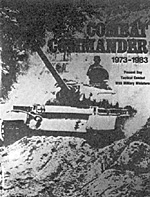 COMBAT COMMANDER was published in 1978. It is a set of rules covering the period 1973-83.
The rules are intended for battalion to regimental level actions. Thanks, guns, and heavy weapons are represented 1:1 by models, while infantry is represented by squad and fire team size stands. The ground scale is 1 inch equals 50m, and each turn represents 90 seconds.
COMBAT COMMANDER was published in 1978. It is a set of rules covering the period 1973-83.
The rules are intended for battalion to regimental level actions. Thanks, guns, and heavy weapons are represented 1:1 by models, while infantry is represented by squad and fire team size stands. The ground scale is 1 inch equals 50m, and each turn represents 90 seconds.
The sequence of play is fairly conventional. It is: 1. Side A moves; 2. Both sides fire non-infantry weapons; 3. Side B moves; 4. Both sides fire all weapons.
The fire steps are broken down with weapons firing with a fixed sequence within them. Basically, ATGM fire is allocated, direct and then artillery indirect fire are resolved, infantry fire (if applicable) is resolved, and then the results of ATGM fire are determined. Within the firing classes, the order of firing is determined randomly for units from both sides. The only unusual feature is the determination at the beginning of each turn of which player will be side A.
Each player rolls a 1-6 die, adds any modifiers, and the player with the higher result left has his choice of becoming A or B for that turn. For each successive turn a player has won the choice, he subtracts one from his roll. This continues up to a maximum of 3, or until the other player wins the initiative. As soon as the initiative changes hands, all accumulated penalties are dropped.
Rather than using dice to generate random numbers for fire, the rules use a normal deck of playing cards with the picture cards removed, thus leaving 4 sets of cards numbered 1-10. The advantage of this is that when an effect reduces the probability of success for fire by 1/2 or 3/4, the rules merely specifiy eliminating certain suits from the range of numbers that will succeed. For example, if a 1-4 was originally needed to successfully hit a target, if the chance of success was reduced by half, a 1-4 of a black suit could be required instead.
The rules are written with an eye to tactical details and finesse. An example of this is the treatment of hull down positions. Instead of a vehicle being merely hull down or not, each crest is rated for the amount of protection it can provide with a specific numeric value. This value is then compared to the number showing where an armored vehicle is hit. If the vehicle is hit in an area equal to or below the crest's value, the crest is hit instead.
Another example of the detail involved is in the spectrum of options allowed to a vehicle which is the target of an ATOM. If the target or a friend succeeds in spotting an incoming missile, it and nearby friends may choose to use suppressive fire, evade by swerving, or dodge into a covered position. The chances of both spotting a missile and success in avoiding it are determined by the specific type of missile fired, the range, and the type of unit the missile is fired at.
The infantry rules are also quite comprehensive. Each infantry unit is numerically rated for aggressiveness, staying power, and tactical expertise. These values are used in determining how successful unit is in such activities as assuming improved positions, moving under fire, and making close assaults.
Other sections of the rules cover in detail areas such as aircraft operations, helicopter operations, electronic warfare, mines, chemical weapons, and nuclear weapons. The rules include complete vehicle data and organizations for NATO, Warsaw Pact, and Arab and Israeli forces. The data suffers a bit from the age of the rules, and amongest things not covered are the Leopard II, and the effects of Cobham and similar composite armors.
Overall these rules are quite interesting, and contain some information that can be integrated with other rules for the same period if COMBAT COMMANDER is not to your individual taste. The 79 page COMBAT COMMANDER rule book is published by Enola Games, 14 Pierrepont St., Brooklyn, NY 11201 and is carried in THE COURIER Inflation Fighter List.
More Reviews
-
MiniFigs Superdetailed 15mm Napoleonics (figures)
Tin Soldier 15mm Dark Ages (figures)
Combat Commander (rules)
War of 1812 Resource Guide (bibliography)
Back to Table of Contents -- Courier Vol. 2 #2
To Courier List of Issues
To MagWeb Master Magazine List
© Copyright 1980 by The Courier Publishing Company.
This article appears in MagWeb (Magazine Web) on the Internet World Wide Web.
Other military history articles and gaming articles are available at http://www.magweb.com